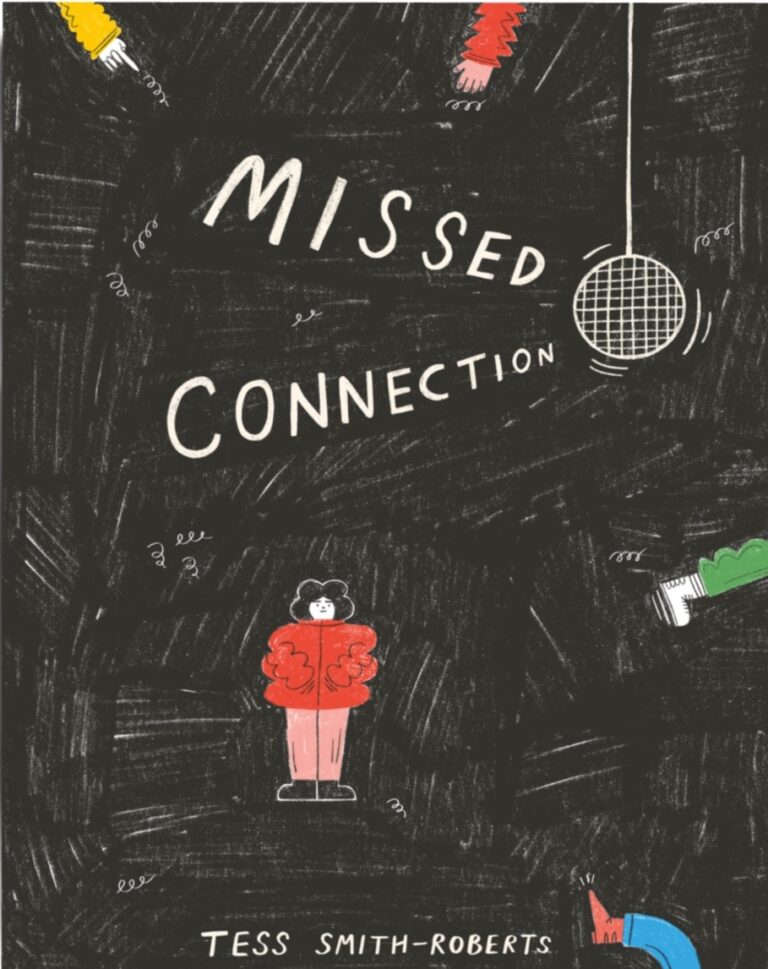It took a few pages to decide where I stood on Tess Smith-Roberts’ Missed Connection, but only a few. There’s a rudimentary quality here that might present an obstacle for some readers, an intentional effect that masks a remarkable sense of design and composition. The book lives and breathes on the strength of pastel tones, no small feat.
This is essentially a storybook, albeit one with cuss words. It’s about lonely people wandering around the city, surrounded by strangers despite their isolation. That’s the crux of the problem: the protagonist for the first third of the book, Grace, is grasping for any kind of substantive connection. She sits at home and spends her time watching soap operas that fill the hours but little else. She goes out to a party, takes a ceramics class. It doesn’t stick.
Eventually Grace meets Kitty. Kitty is more or less in the same boat. She can’t find a job, can’t find any luck with online dating. There’s a page with Kitty sitting on the toilet scanning social media while asking herself “why is everything happening for everyone else?” Such a simple question to draw so much blood from the unwary reader! Is there a more modern sensation than the unique twinge of jealousy that accompanies close observation of other peoples’ social media feeds? Even if you acknowledge on some level that other people’s lives are just as desperate and stage managed as yours, the mere illusion that other people are actually managing to live their best lives in 2020 is enough to hurt like the twisting of a knife.
How dare they.
 Grace and Kitty come together in the final third of the book. There’s no friction, no “will they or won’t they?” or missed connections. They meet-cute in the supermarket and agree to meet again. Sometimes it really is that simple. But the previous two sections assure us this is by no means standard operating procedure.
Grace and Kitty come together in the final third of the book. There’s no friction, no “will they or won’t they?” or missed connections. They meet-cute in the supermarket and agree to meet again. Sometimes it really is that simple. But the previous two sections assure us this is by no means standard operating procedure.
And that’s the gut-punch waiting for the reader at the end of the book: this really is just a simple story about being lonely and depressed and finding a lover. The main conflict - the only conflict, really - is between the two protagonists and their respective loneliness. It’s hard to be both hemmed in by the constant presence of other people and also bereft of anyone with whom you can ever truly relax. It leads a body to sickness from pining for peace. There’s no conflict between the protagonists once they meet because that in itself is the most pure kind of fantasy imaginable to so many people in 2020: just to meet someone else you don’t mind being in the same room with for an extended period of time. Someone with whom to share a lunch. Our lives are so often and so thoroughly not our own that the most banal and domestic pleasures seem at times more distant than the moon.
In 2008 Tom Spurgeon coined the term “decency fantasy” to describe a certain kind of narrative that hinges on the fantasy of pleasingly mundane domesticity. In hindsight this seems a prescient label. Stories that revolve primarily around people being reasonable and working together amicably to solve common goals seem positively transgressive in an era when almost everything else in our lives sinks further into the realm of the brittle and combative. Back in 2008 when Spurgeon coined the term low-stakes slice of life was a relatively small part of the comics ecosystem, but these kinds of stories seem to hit a nerve at this particular point in time. It’s rough out here on these mean streets. People get thirsty for virtue.
 Smith-Robert’s pages are defined by flat planes of pleasing, hand filled color. Occasionally geometric motifs intrude, op art eruptions of tile floors across soft tones. This book made me realize that I didn’t know how influential Paper Rad would be, in hindsight, but their mixture of Fort Thunder primitivism, riotous digital imagery, and a subtly classical design sense can be seen across a number of disparate artists. Missed Connection recalls some of these more combative experimental comics of the aughts, filtered through minor keys and dependent on a decidedly less aggressive palette but retaining a similar approach to narrative sequences built around collage and repetition. That we should live to see the disconsolate hybrid offspring of Kramer’s Ergot and Hope Larson in one - an age of miracles.
Smith-Robert’s pages are defined by flat planes of pleasing, hand filled color. Occasionally geometric motifs intrude, op art eruptions of tile floors across soft tones. This book made me realize that I didn’t know how influential Paper Rad would be, in hindsight, but their mixture of Fort Thunder primitivism, riotous digital imagery, and a subtly classical design sense can be seen across a number of disparate artists. Missed Connection recalls some of these more combative experimental comics of the aughts, filtered through minor keys and dependent on a decidedly less aggressive palette but retaining a similar approach to narrative sequences built around collage and repetition. That we should live to see the disconsolate hybrid offspring of Kramer’s Ergot and Hope Larson in one - an age of miracles.







